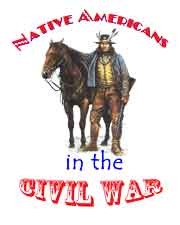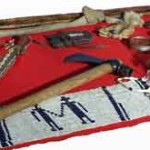Civil War and the Indian Conflicts in Pennsylvania
NATIVE AMERICANS IN THE CIVIL WAR
Here’s what Ken Burns didn’t tell you!
Civil War buffs, family audiences, and students of Native American history of all ages will be fascinated by the surprising, almost unknown story of the Native American warriors who fought on both sides in the War Between the States. An estimated 20,000 Native Americans of various backgrounds participated in the conflict. Participants in this program will learn why, where, and how they took part as they explore the divided loyalties and complex political realities that pitted Native American tribes –even family members– against each other in battles that raged across America. The presentation also will trace the astonishing biographies and impressive exploits of important Native American leaders in the War. One of them was a full-blooded Seneca chief who was a Brigadier General and Aide to General Grant and drafted the terms of surrender signed at Appomattox! Offering a new perspective on the Civil War that explores its impact on the fate of Native Americans, this program begins with a lecture. It goes on to offer the opportunity for a lively Q and A session and for in-depth post-presentation conversation that well-informed audiences often enjoy. Exhibit material available for browsing will focus on individual Civil Warriors and Native battle sites in the West. Designed for adult audiences.
War buffs, family audiences, and students of Native American history of all ages will be fascinated by the surprising, almost unknown story of the Native American warriors who fought on both sides in the War Between the States. An estimated 20,000 Native Americans of various backgrounds participated in the conflict. Participants in this program will learn why, where, and how they took part as they explore the divided loyalties and complex political realities that pitted Native American tribes –even family members– against each other in battles that raged across America. The presentation also will trace the astonishing biographies and impressive exploits of important Native American leaders in the War. One of them was a full-blooded Seneca chief who was a Brigadier General and Aide to General Grant and drafted the terms of surrender signed at Appomattox! Offering a new perspective on the Civil War that explores its impact on the fate of Native Americans, this program begins with a lecture. It goes on to offer the opportunity for a lively Q and A session and for in-depth post-presentation conversation that well-informed audiences often enjoy. Exhibit material available for browsing will focus on individual Civil Warriors and Native battle sites in the West. Designed for adult audiences.
The Indian Wars in Pennsylvania
When European powers fought each other for dominance in 18th Century America, Native Americans took sides in the conflict. Because of the friendship between the Lenape, the Quakers, and other like minded Europeans, peace lasted longer in Pennsylvania than in other states. Eventually, however, the French and Indian War erupted here. Betrayed and their way of life threatened by the infamous Walking Purchase and treaty violations, the once-peaceful Lenape joined the fray on the side of the French. The fighting drove settlers from Western Pennsylvania until the Lenape recognized their cause was hopeless, and the Proprietors of Pennsylvania decided that buying peace was cheaper than waging war. But Pontiac’s Rebellion ignited a struggle in the Ohio River valley that lasted until “Mad” Anthony Wayne smashed the Indian resistance at the Battle of Fallen Timbers in 1794. Participants in this program will trace the tragic consequences of the breakdown of respect between peoples as they delve into the Natives’ struggle to survive, the complexities of Native and European interaction, and the battles of the early Colonial era. Designed for adult audiences.
 Penn / Lenape Wampum Belt & Tomahawk
Penn / Lenape Wampum Belt & Tomahawk
PENNSYLVANIA, THE PEACEABLE KINGDOM
Featuring the dramatic story of Indian Hannah, this is an in-depth look at the cordial relations of the Lenape, Quakers, and Moravians during the early settlement of Pennsylvania and at the later conflicts arising with other Euro cultures. Once respected “Grandfathers” who counseled for peace and arbitrated among the Native Nations, the Lenape were forced to negotiate desperately in a bid to maintain their values and relationship to their part of “Turtle Island.” Designed for adult audiences.
In Remembrance of the Treaty of Shackamaxon
From the Children of Tamanend, Lenape
To the Children of William Penn,
First Proprietor of Pennsylvania.
For we were ever sworn to be friends, and we will walk together like brothers.
This is a follow-up to Lenape Lifeways 1: INTRODUCING THE FIRST PEOPLE OF PENNSYLVANIA this program explores in depth the peaceful ways of the Lenape and the conflicts that arose with the many European cultures that came to our shores. As “the Grandfathers” who counseled for peace and arbitrated issues among Native Nations and later as the negotiators who tried to maintain their hold on both their cultural values and their relationship to their part of “Turtle Island,” the Lenape struggled for a balance between many worlds. Meeting with and dealing with the early explorers/traders such as the Portuguese, Holland Dutch, and French, then with the settlers (English, Germans, Scottish, Irish, and Welsh) and “Americans,” the Lenape had many choices to make. None were easy. Learn about the Lenape in peace and conflict – how they lived in love with William Penn and the Quakers, fought in the French and Indian War, then served as Commissioned Officers in Washington’s army during the Revolutionary War, and how they were forced across the continent.
